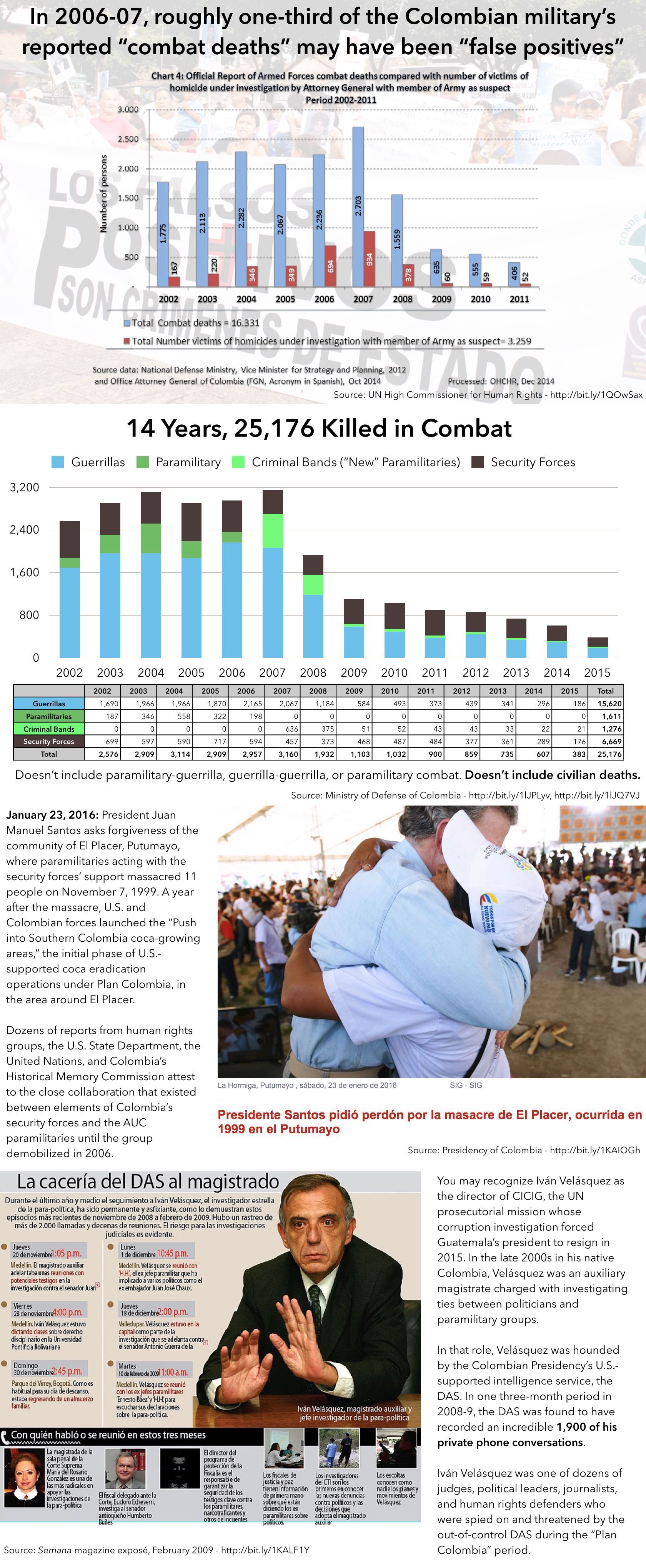Scandal Upon Scandal
Even without considering human rights violations, Colombia’s armed conflict carried a very high human cost during the “Plan Colombia” years. Colombia’s Defense Ministry has counted 25,176 soldiers, police, guerrillas, paramilitaries, and “criminal band” members killed in combat between 2002 and 2015.
The cost grows far higher, though, when adding human rights abuses committed against non-combatants. Though illegal armed groups of the left and right carried out more extrajudicial killings, massacres, disappearances, kidnappings, displacements, sexual violence, and other crimes, Colombia’s U.S.-backed security forces committed an alarming share of abuses, especially during Plan Colombia’s first years. The armed forces and police stand widely accused of three broad phenomena, listed below this graphic.

- Collaboration with paramilitary groups: whether through active aiding and abetting, or simply turning a deliberate blind eye, Colombia’s security forces share responsibility for numerous massacres and other abuses committed by Colombia’s United Self-Defense Forces of Colombia (AUC) paramilitaries, which at its peak was killing a multiple of the number of people that the FARC and ELN were killing. This collaboration has been documented in innumerable human rights reports, including from the U.S. government (State Department human rights reports and human rights certifications) and Colombian government (Center for Historical Memory).
- "False Positives": Colombia’s security forces, principally its Army, killed “potentially 5,000 victims” (UN High Commissioner for Human Rights estimate) most of them between 2002 and 2008, often to boost body counts by falsely presenting them as armed-group members killed in combat. In 2006 and 2007, the worst years for this phenomenon, Colombia’s Defense Ministry claimed to have killed 4,939 people in combat. Today, Colombian civilian and military judicial authorities are investigating 1,628 homicides allegedly committed by Army members. That is roughly a three-to-one ratio.
- Abuses by intelligence services: The Administrative Security Department (DAS), the Colombian Presidency’s U.S.-supported intelligence service, was involved in two alarming scandals during the Plan Colombia years. In 2006, Colombians learned that President Álvaro Uribe’s intelligence chief, Jorge Noguera, had worked so closely with paramilitary groups that he even shared lists of activists and labor leaders for them to target. In 2009, DAS agents acting with top directors’ knowledge were found to have carried out an extensive campaign of illegal wiretaps, surveillance, and issuance of threats against civil-society leaders, journalists, judicial investigators, and opposition politicians. The DAS was ultimately dissolved. In 2014, the discovery of “Operation Andromeda” revealed that Colombian Army intelligence was wiretapping, and intercepting the e-mail communications, of governmental and non-governmental personnel, including the government’s own team participating in negotiations with the FARC in Havana, Cuba.
At first, especially in the cases of paramilitary collaboration and “false positives,” U.S. officials missed or downplayed the severity of the phenomenon. Eventually, though, U.S. pressure to hold the perpetrators responsible proved instrumental to holding at least some officers responsible. (Human rights conditions attached to U.S. assistance, discussed in the next panel, played a central role in exerting that pressure.) The increased accountability in turn helped improve the Colombian military’s human rights record: though allegations of abuses persist, they are much fewer than during Plan Colombia’s early years.
 15
15